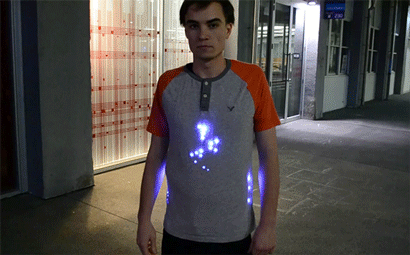
As more and more of our technology becomes automatic, wireless, invisible, and connected, it simultaneously has a greater potential to slip from our immediate attention. Matt Martin, a Masters student at Auckland University of Technology in New Zealand, is most interested in how technology affects us. He designed “Wearable Beacon,” a seemingly normal shirt that flits a trail of LED lights when it comes within the range of a Bluetooth device.
“It is to provoke the viewers to see technology as an influence to us like our own nervous system, but without others being familiar or knowing of it.”
The shirt contains 31 NeoPixel strips, adding up to a total of 1,056 pixels. They are sewn onto the shirt and affixed to an Arduino Yun, Mega, and a Bluetooth Mate Silver. Martin explains:
“I have the Arduino Yun connected to the Bluetooth module to pick up the bluetooth devices (hoping to do the same for wifi) and it identifies each device by their name. This information is sent from the Yun to the Mega. The Mega then creates a light animation for each device detected.”
As gargantuan and ubiquitous as the world of connected devices is, wireless connections, like Wi-Fi and Bluetooth, still seem to remain largely intangible when it comes to the physical world. Sure, we carry and interact with our devices daily, but the wireless signals which they send and receive are oft taken for granted. Martin’s “Wearable Beacon” digs up these invisible signals and reconfigures them in a way that demands attention. Truly, the reactions of observers were his main motivation behind this build. He says:
“Most people were curious as to how it was working and would either approach me or discuss among themselves about it. Really it was just great to see people look away from their phones for a few seconds, although I am not used to that sort of attention! Haha.”
How do you feel about the invisible ubiquity of connected technologies? What project would you build to express that? We’d love to hear about it in the comments.
The shirt illuminates what Martin describes as a “nervous system pattern,” visible in the demo below. If you’d like to see more from Martin, be sure to check out his blog.
[via Adafruit]
ADVERTISEMENT









